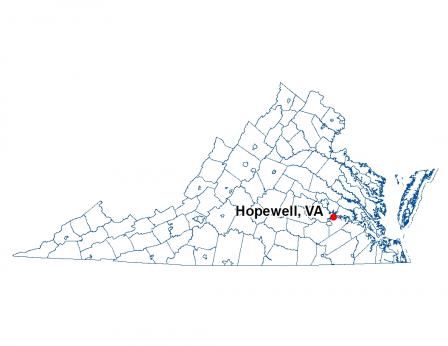Stories of Progress in Achieving Healthy Waters
U.S. EPA Region 3 Water Protection Division
Hopewell, Virginia • March 17, 2016
Actions being taken by a Hopewell, VA. plant as a result of a major EPA Clean Air Act settlement will significantly reduce nitrogen pollution that falls from the atmosphere and impacts the Chesapeake Bay and local waters.
A 2013 consent decree addressing Clean Air Act violations at the Honeywell Resins and Chemicals LLC plant in Hopewell is expected to reduce annual emissions of nitrogen oxide (NOx) by an estimated 6,260 tons – more than 7 percent of the cuts needed from air sources to meet water quality goals of the Chesapeake Bay Total Maximum Daily Load (Bay TMDL).
The Honeywell Hopewell plant is the world's largest single-site producer of caprolactam used in the production of nylon, and ammonium sulfate used for fertilizer.
Under the consent decree, Honeywell agreed to pay a $3 million civil penalty, perform a mitigation project valued at about $1 million, conduct a third-party benzene waste operation audit, develop an enhanced leak detection and repair program, and install injunctive relief, including selective catalytic reduction devices that reduce NOx emissions, totaling approximately $66 million.
According to the complaint filed by EPA and the Virginia Department of Environmental Quality, the facility violated Clean Air Act limits on emissions of NOx, benzene and other volatile organic compounds, and particulate matter. The plant also allegedly failed to comply with requirements to upgrade air pollution control equipment, detect and repair leaks of hazardous air pollutants, and form benzene waste safeguards.
While the Honeywell action, scheduled to be completed by 2018, will improve air quality, it will also have an impact on water quality by reducing the nitrogen that settles out of the atmosphere to land or water. Excess nitrogen, phosphorus and sediment lead to murky water and algae blooms, which block sunlight from reaching and sustaining underwater Bay grasses, and create low levels of oxygen for aquatic life, such as fish, crabs and oysters.
The Honeywell plant is within the Chesapeake Bay’s NOx airshed, the area from which most of the atmospheric deposition of nitrogen reaching the Bay watershed is generated. Air sources account for about one third of the total nitrogen loads delivered to the lands and tidal waters of the Bay watershed. Actions by EPA and its state partners to implement the Clean Air Act have led to a steady decline in that airborne pollution and have been a key factor in the overall progress to date in satisfying the Bay TMDL.

-
Help From Above For Bay Waters (PDF)(1 pg, 626 K,
03/17/2016)
Actions being taken by a Hopewell, VA. plant as a result of a major EPA Clean Air Act settlement will significantly reduce nitrogen pollution that falls from the atmosphere and impacts the Chesapeake Bay and local waters
